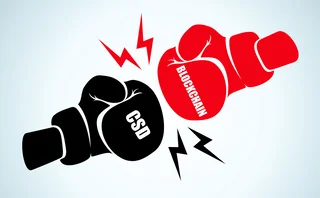
Rivals gear up for forex clearing
The stage is set for a central counterparty clearing (CCP) system for foreign exchange as two potential providers moved their plans forward last week, reports RiskNews' sister publication, FX Week .
"A number of banks have said to us that they can see significant scope for operational advantages if we could net settlements multilaterally and then pass the resulting net amount to continuous-linked settlement (CLS) for settlement," said Rory Cunningham, director of strategy and development at LCH.Clearnet in London.
Currently, all individual forex transactions are reported to CLS and settled individually, whereas in the securities market, equities and bonds are netted down and the settlement system handles the net amount each day. This forms LCH.Clearnet’s core business.
But although LCH.Clearnet’s proposal for a central clearing system would affect the way the ‘whole value chain’ would work, it would not replace CLS, said Cunningham. "We would still see the need for a payment versus payment (PvP) system but possibly by currency pair per day rather than for each individual transaction." It would not be an exchange model with its associated regulatory framework, he said.
The CME/Reuters deal, however, has triggered an industry-wide debate over the blurring of distinctions between exchange and interbank business.
For some, the CME already has the structure to provide CCP clearing on a netted basis for foreign exchange. "The CME is already working with CLS for quarterly deliveries – it has structured all its delivery settlements around CLS – and to settle forex futures you must be a third-party CLS member anyway," said Julian Knight, forex head at Fimat in London. "It’s an obvious benefit that the CME is already embracing CLS – it is putting forward its own clearing model but using the best bits of CLS to facilitate currency deliveries."
The CME settles forex deals through CLS just as in the traditional spot market, but it sends one netted event per quarter, per currency pair. It also remains the central counterparty, "so you always have one netted currency position with one counterparty. Since that doesn’t mature until the contract expires, there is only one position between the bank and the CME," said Rick Sears, CME’s forex managing director.
This could prove to be a key revenue issue, particularly for the large forex banks, as a bank might pay a $2.50 charge per spot deal in the traditional market, but in the futures model it would pay only one per quarter.
For LCH.Clearnet, the realisation is still "some way away", said Cunningham, as it will need the co-operation of organisations providing the trading systems as well as central bank, regulatory and supervisory bodies.
"We would need to get sent the business from the market in the same way as we do from the stock exchange, and we can’t move unless the market decides to take this step." LCH.Clearnet has the benefit that the main investment and commercial banks are already its clients – but the problem would be to persuade those clients to agree. "[A new clearing system] would affect a bank’s back office, risk profile, prime brokerage, clearing, as well as front-office desks, so the bigger the banks are, the more complex it would be for them," said Cunningham. At a meeting held by LCH.Clearnet in December, out of about 12 banks, eight were keen to look at the concept, he said.
Meanwhile, Fimat already plans to be one of the first five ‘beta-test clearers’ on CME FX on Reuters. "The CME/Reuters agreement provides a very liquid market and from Fimat’s point of view it’s a market we have expertise in clearing," said Fimat’s Knight. "Distribution is going to be huge – it is going to draw the forex futures product to the mainstream forex market."
Only users who have a paid subscription or are part of a corporate subscription are able to print or copy content.
To access these options, along with all other subscription benefits, please contact info@risk.net or view our subscription options here: http://subscriptions.risk.net/subscribe
You are currently unable to print this content. Please contact info@risk.net to find out more.
You are currently unable to copy this content. Please contact info@risk.net to find out more.
Copyright Infopro Digital Limited. All rights reserved.
As outlined in our terms and conditions, https://www.infopro-digital.com/terms-and-conditions/subscriptions/ (point 2.4), printing is limited to a single copy.
If you would like to purchase additional rights please email info@risk.net
Copyright Infopro Digital Limited. All rights reserved.
You may share this content using our article tools. As outlined in our terms and conditions, https://www.infopro-digital.com/terms-and-conditions/subscriptions/ (clause 2.4), an Authorised User may only make one copy of the materials for their own personal use. You must also comply with the restrictions in clause 2.5.
If you would like to purchase additional rights please email info@risk.net
More on Settlement risk
Margin settlement risk and its effect on CVA
Sponsored feature: CompatibL
CLS to replace core settlement system
Overhaul will leverage conventional technology rather than blockchain solution that underpins new CLSNet service
Netting no problem for blockchain, tech firms tell regulators
Firms say DLT can sit with current market practice, but instantaneous settlement 'not desirable'
Distributed ledger innovators imagine a world without CSDs
CSDs counter they fulfil functions blockchain cannot, and regulatory changes are needed to disintermediate them
Banks eye Traiana for EM forex netting service
Industry turns to utility as CLS emerging markets push stalls
Euroclear and Clearstream granted time to agree joint road map
Icma ERC continues to push for plans to improve Bridge settlement times
CLS facing obstacles adding RMB to its platform
RMB volumes set for growth but settlement remains an issue
FX clearing a priority for 2014, vows CLS chief
Working with banks and CCPs to facilitate central clearing of OTC forex options is 'high priority strategic initiative' for CLS this year, says chief executive David Puth







